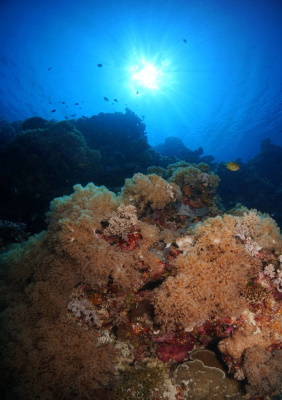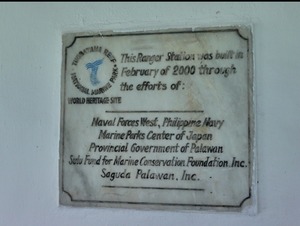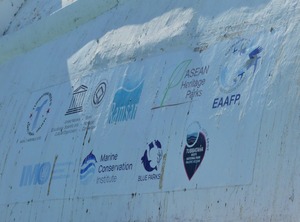Tubbataha Reefs

Tubbataha Reefs Natural Park covers a pristine atoll reef ecosystem with a very high diversity of marine life.
The park, comprising the Tubbataha and Jessie Beazley Reefs, lies in the remote and undisturbed Sulu Sea. It protects over 360 species of coral. Animal species that inhabit the reefs include whales, manta rays, lionfish, turtles, clownfish, spotted dolphins and sharks. It also serves as an important nesting site for seabirds.
Community Perspective: this is the territory of the liveaboard dive ships; Zoë describes such an experience. Clyde has added the adventure by chartered boat with like-minded WH travellers on a trip for non-divers.
Map of Tubbataha Reefs
Community Reviews
Boj

Reasonable scuba divers will agree that, as far as the possibility of marine life encounter is concerned, luck is a constant factor, along with all other environmental conditions, as well the divers’ skill and general behaviour. “It’s not an aquarium down there after all,” is an easy but a necessary caveat. In that regard, I and my fellow divers thank ours lucky stars for the Tubbataha superlatives experience (dive safari in March 2025).
However, to fully appreciate the site, it would be necessary to look back and stocktake decades of efforts from various stakeholders in Palawan - academe, fisherfolk communities, national and local government agencies, NGOs, international organisations, etc., whose efforts made Tubbataha currently a model for marine site conservation.
From the 70s to early 90s, local communities struggled with the declaration of the site as a strict “no-take zone,” and condemned concepts of heritage and conservation as anti-poor and useless. Years later, Tubbataha showed signs of recovery, commercial fish catch in waters outside the park increased, and created a new generation of conservation believers.
Clyde

I visited this WHS in Spring 2025 thanks to a special meet-up (9 pax) organised by Thomas Buechler on a liveaboard catamaran for 2 nights. The Tubbataha Reefs Natural Park is made up of Tubbataha Reef (South Atoll and North Atoll) and the smaller Jessie Beazley Reef, located in the middle of the Sulu Sea 150 kilometres southeast of Puerto Princesa. It lies at the apex of what is known as the Coral Triangle, a global centre of marine biodiversity. The natural park is a bird (also a Ramsar site) and marine sanctuary with a very high density of marine species, especially coral, with 72% of all coral genera in the world.
Shortly after departing from Puerto Princesa in the late afternoon in very dark skies and a light drizzle, the very calm seas sheltered by the nearby Palawan land became a bit choppy as we sailed into open seas for approximately 15 hours straight, causing slight seasickness to a few of us. Luckily it wasn't too bad and just before sunset a pod of dolphins lifted our spirits. The seasickness pills kicked in and helped those who took them and after dinner and a couple of beers, chatting on the most remote WHS and each other's missing WHS, we went to sleep in our cabins. As an aside, in the middle of the night our captain and crew decided to moor our catamaran for a while with the returning larger liveaboard ship for divers from Tubbataha for a quick chat in the middle of the pitch black Sulu Sea.
We were all thrilled to be visiting such a "remote" and special place soon but nobody (including the captain and crew!) was expecting the clear skies and bright sun that woke us up the following morning from sunrise as we reached the Tubbataha Reefs. The North Islet, also known as Bird Islet, in the North Atoll is a special nesting site for hundreds of seabirds (sandpipers, sooty terns, great crested terns, frigatebirds, brown boobies, red-footed boobies, gannets, Pacific reef herons, brown noddies and black noddies) but I was already able to spot most species resting on pieces of driftwood or feeding out at sea. The Bird Islet is also known as one of the few intact seabird rookeries in Southeast Asia and since 2015 Tubbataha Reefs Natural Park became part of the Asian-Australasian Flyway Network Partnership after being also declared an ASEAN Heritage Park in 2014.
First things first; we contacted the Ranger Station to confirm our arrival and a whole ranger team on board a Tubbataha patrol boat approached our catamaran, all proudly wearing blue Tubbataha Reefs Natural Park - World Heritage Site rashers. Our party was delighted to see the ranger team sport such clothing so we asked if they had any similar merchandise for sale, to which they replied yes and we gladly agreed to visit their old ranger station (built in the year 2000; a bigger and higher Ranger Station is currently under construction) in the afternoon when the tide was higher and after they finished their morning patrol. They showed us the same great information video available online titled Tubbataha: A National Treasure on a laptop with portable speakers and they briefly explained some of the basic rules of this "no-take zone" and the largest marine protected area in the Philippines.
Knowing that we had to return to the North Atoll in the afternoon, the plan was to snorkel between Amos Rock, Wall Street and the Grogorian Channel diving sites to make the best of the shallower water and currents due to the low tide. The first thing I saw once in the water and just after defogging my mask, was a group of white-tip reef sharks, followed by a pair of mating sea turtles. Even though the variety of coral and fish species is remarkable, especially since we were only snorkelling at a site which is best explored by diving, what impressed me most was the clarity of the waters and the visible currents, quite warm at the surface and very cool at the bottom. On the different brain coral, branched coral, soft coral, rose coral and fan coral, there were different bright coloured sea slugs or nudibranchs and I also spotted a couple of giant and yellow-edged moray eels. Philip also managed to spot a blue-spotted stingray.
Next we headed towards the South Atoll where we were able to see a couple of rusty shipwrecks packed with seabirds on the surface, a large lighthouse built in the 1980s and a long sandbar. The different shades of blue of the surrounding waters were incredible and we felt super lucky as the weather was much better than we had hoped for initially before departure. We snorkelled close to the reef near the lighthouse between the Staghorn Point and Triggerfish City diving sites. The currents here were a bit stronger than the previous snorkelling site with different currents meeting from both sides of the South atoll's reefs. For this reason too there seemed to be much more schools of fish and blue starfish here.
After snorkelling we sailed back to the North Atoll and used a zodiac to reach the Ranger Station and bought some unique merchandise. We signed their guestbook and whiteboard and took a group photo with the rangers. At the old ranger station there is a small marble plaque with the WHS name only and then there is big sticker/poster-like sign affixed on the side of the ranger station also including the UNESCO symbol (no date and no inscription criteria). Since the tide was not so high, we could easily spot countless sea turtles and black-tip reef sharks roaming around the incredible ranger station basketball ring and "court". When the ranger team saw that we did not heed their warning to beware of any stingrays hidden in the sand and shallow waters to take photos of the basketball ring and the UNESCO WHS sign, they decided to throw us their ball and we really enjoyed a surreal and unforgettable experience of scoring a couple of 2 and 3 pointers in the middle of the Sulu Sea.
Towards sunset we went closer to Bird Islet, fully covered with seabirds, with another shipwreck and we also had a last chance of swimming at Shark Airport diving site. However, the tide was very high and the double rainbow was followed by cloud cover which meant that the water was far too dark to really see anything by simply snorkelling at such a deep diving site. Randy, my wife and I were the only three passengers who wouldn't have minded another quick swim, but the captain gladly decided to side with the majority and start sailing back for circa 16 hours to Puerto Princesa, also to avoid the storm that was forming. We left the threatening dark clouds and rain behind us and woke up near sunny Puerto Princesa in the morning.
A big thank you once again is due to Thomas for organising such a trip for non-divers; probably none of us would have ever visited otherwise! Visiting such a unique and remote WHS with like-minded WH travellers was obviously a great experience and hopefully other similar experiences will follow.
Zoë Sheng
Chinese-Canadian - 26-Dec-22 -

I had previously (for some reason) rated this as a five star visit but I have no clue idea why. Getting back to this now only because it's been a long time since the last review I corrected it. I didn't take a photo of the ranger station and my friend once sent me a video but it wasn't his either so the "copyright" (=bragrights?) aren't clear and in the end it's no big deal. Random underwater shot from the diving it is.
The only way to see this place is by taking a liveaboard into the reef area. It's going to take a a week to explore it and there isn't really much you can do about it. Even if there would be a shorter trip available then it's not worth it. You will need to soak up the full experience.
So I don't rate this as highly as expected for a natural and dive site. "Tubbataha is life" says their slogan and I got a t-shirt (hardly worn because it's too pretty) with the same, some environmental staff comes on board the first night and give you speech on how important the reefs are but in the end you hardly get to see any of the "special life" status. Yes, reefs are important but should I really feel this site is special because they protect it and the rest of the world is raping the underwater reefs and overfishing? Hmm, debatable. The underwater is thrive and according to the season this could change for other visitors but there were no schools of large fish, mantas were never spotted, and the whaleshark promise of the site has a very low chance. We did see whalesharks 3 times actually, but just like the mantas they would swoop by like a submarine and far enough away that you don't really get to see it. Does that beat going to the Okinawa aquarium to see one? For me, yes, but for someone paying a lot of money to think they will get to see a whaleshark in the wild then don't bother. You get to see a lot of nudibranches, not even good ones at that, and crustaceans, but nothing ever got my heart pumping.
Anyhow, I'm too negative. The diving isn't bad in any way. Each time has something to show and if you are just there to see things whatever comes your way then you'll be happy with the scuba activity. However, even other divers on the boat were disappointed because I believe the site is boosting itself as a marvel of nature. Similar to the underwater cave system were it's presented as an amazing trip but in the end you just sit in a boat and look at rocks for 10 minutes, maybe this is a Filipino exaggeration and disappointment can kick in when you previously saw better sites before, especially sites that don't claim they are "THE spot for whalesharks", "nature as it's best" etc. This place is nothing compared to Palau, PNG, Solomons, Papua, Raja Ampat, even Northern Palawan has better diving and I think Malapascua had better reefs (with dynamite fishing unfortunately).
In the end I suppose I should be happy that there is a large water system on Earth that is protected and conversed, no matter if it's a WH or not. I didn't check but I guess it's mainly inscribed for certain biodiversity ratings and those nerdy stats aren't important to me. I enjoy diving and I enjoy diving at a good spot, but it will never be on the same level as Galapagos, Cocos or Palau.
FYI if you aren't aware of this there is only scuba diving for this site. You can potentially snorkel but everything is so deep that you will not see much - or anything - and the shallower areas around the ranger station are just sand and maybe some turtles but I mean - that's why you came here for, right? :p
Lastly, many people combine Puerto Princesa Subterranean River with this trip because you leave the boat early.
Juan Antonio G. Menchaca
We arrived aboard the Liveaboard Diveboat Nautica.Great diversity of marine life. Turtles, we saw Pilot whales,lemon sharks and thresher sharks, Manta rays huge shoals of unicorn surgeon fish. Great quantity of sea birds with blue spotted eggs. There is the remains of a ship that had ran aground. Great sunsets. We stayed for a week. Spectacular diving.
Capt. Ingvar T. Swenson
The only experience I have had with Tubbataha Reef is when
I grounded there with a 6000.tons cargo ship in 1973.
The reef was very hard and tore a large hole in my ship.
We had to unload some of the cargo out there and then
proceeded to Iloilo for repairs,
Community Rating
Site Info
- Full Name
- Tubbataha Reefs Natural Park
- Unesco ID
- 653
- Country
- Philippines
- Inscribed
- 1993
- Type
- Natural
- Criteria
-
7 9 10
- Categories
- Natural landscape - Marine and Coastal
- Link
- By ID
Site History
2009 Extended
To include Jessie Beazley Reef.
2009 Name change
From "Tubbataha Reef Marine Park, Philippines", to "Tubbataha Reefs Natural Park"
1993 Inscribed
Site Links
Unesco Website
Official Website
In the News
Connections
The site has 22 connections
Constructions
Damaged
Ecology
Geography
Timeline
Trivia
WHS on Other Lists
World Heritage Process
Visitors
14 Community Members have visited.
The Plaque
 (photo by Clyde)
(photo by Clyde) (photo by Clyde)
(photo by Clyde)